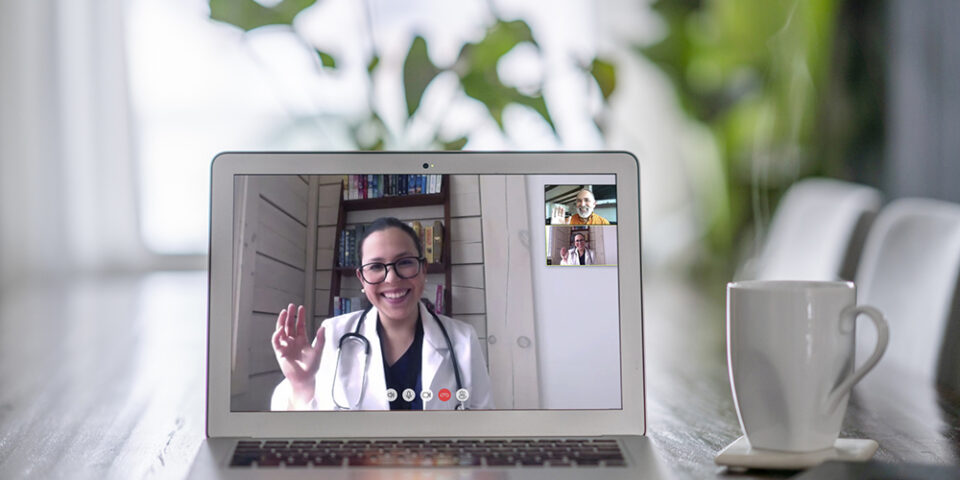Is telehealth right for you?
These days, things look much different when it comes to accessing care. Although telehealth has been around for several years, the COVID-19 pandemic prompted skyrocketing usage of a service that has now become a staple in care delivery.
Primary care physician Rebecca Smith, MD, discussed how telehealth is changing the way health care is delivered and how you can benefit from it.
What is telehealth?
Often considered a modern-day house call, Dr. Smith said telehealth is defined as the delivery of health care when the patient and provider are in different locations. Electronic devices are used so patients can be seen in the privacy of their home or wherever they might be. Telehealth is sometimes referred to as telemedicine or virtual care.
Some examples of different types of telehealth include:
- Video visits – Care is delivered using both audio and video in real time.
- Audio-only visits – Care is delivered using a telephone or audio-only connection.
- Enhanced video visits – A mobile device is used to capture physical exam data. This includes vital signs like blood pressure, weight and oxygen, as well as photos or video exams of ears and throat and live or recorded audio from a digital “stethoscope.”
- Asynchronous online visits – This is more like an online interview where the provider and patient communicate electronically in a back-and-forth manner, rather than in real time.
How do telemedicine appointments work?
For virtual visits, you’ll need internet access using a computer, tablet or smartphone.
“Although telehealth appointments can sometimes be completed using only a phone, I prefer to have the video available,” Dr. Smith said. “Both the patient and provider benefit from seeing each other. Facial expressions, body language, dress and demeanor are all helpful communication tools. As a bonus, I have loved meeting the patient’s pets and seeing their handiwork and hobbies. I have even had patients take me on a ‘field trip’ to view their medicine cabinet or see parts of their home that might be physically challenging.”
To make a video visit go smoother, here are some quick tips:
- Make sure you’re ready about 10-15 minutes before your appointment to test your equipment and answer any questions.
- Try to find a private spot with no background noise and good lighting. If near a window or lamp, make sure it’s in front of you and not behind you which would make your face more difficult to see.
- Place your device on a level surface instead of holding it in your hand.
- Close other applications on your device to improve your internet connection and reduce distractions. This is especially true for applications that use the microphone or speaker.
- Keep a pen and paper handy to take notes if you need them.
What are the benefits of telemedicine for patients and providers?
Telemedicine’s benefits really became apparent during the pandemic. It was a way to help patients receive care while keeping them safe and reducing the spread of the virus.
“At Prisma Health, telemedicine was live in three practices before the pandemic,” Dr. Smith said. “Then the world went on lock-down and video visits were catapulted into mass use. We stumbled together through technical issues and early versions of software. Today, the biggest benefits I see are saving time sitting in a waiting room, not having to take time off work or find a babysitter and no need for transportation.”
However, not everything can be done virtually. If it is determined during a virtual visit that a test is needed, like a lab or X-ray, the patient would have to drive to the office.
Are there certain populations or industries who benefit the most from telehealth?
Dr. Smith said there are many who benefit from the option of telehealth, including:
- Busy, working people.
- Parents of young children.
- Workers who take time off by the hour to visit the doctor.
- People who cannot drive or do not have reliable transportation.
- Folks who live far away.
- Children with special needs.
- Adults with mobility difficulties.
- Patients who might feel embarrassed sitting in the lobby of a psychiatrist’s office.
- Patients who have recently had surgery.
- Pain management patients needing pill counts.
- College students.
Is telehealth as effective as being seen in person?
“Most of the time, telehealth is as effective as being seen in person,” Dr. Smith said. “That was another lesson we learned in the pandemic. For example, I learned to get pretty creative in directing a patient through a neurological and orthopedic exam with their phone propped up on the counter.”
Does telehealth save patients money?
Patients can same money in time and transportation costs. Most insurers charge the same amount for copay and coinsurance for virtual visits as they would for an in-person visit.
How often is telehealth used and is it expected to increase?
“The use of telehealth has declined since the height of the pandemic, as expected, but I think it is leveling off,” Dr. Smith said. “My practice is averaging 15% for the prior 12 months. Visits with psychiatrists at Prisma Health are closer to 70%.”
Is telehealth the new normal in primary care?
“Yes, virtual care is here to stay, and I am quite glad,” Dr. Smith said. “I like having options for patients to connect with me when it is convenient for them. Every time I discuss when the patient should follow up, I always think, ‘Could this be a virtual appointment?’ and let the patient decide what they prefer. If I change a blood pressure medication, or adjust a patient’s insulin dose, a quick check-in for a video visit is perfect.”
Virtual care is a great option when you need care for minor illnesses as well. Here’s some advice on when online care might be appropriate.
There are a lot of telehealth options online. How can patients find a reputable telehealth provider?
“South Carolina law requires that the physician or provider be licensed in S.C., but not necessarily physically present,” Dr. Smith said. “Some of the new telehealth services advertised are staffed by providers on the other side of the country, or world, who have obtained a S.C. license. If in-person follow-up is needed, that won’t be an option.”
Prisma Health providers use an easy-to-access video platform that does not require downloading any apps.
“If you have a Prisma Health doctor, chances are they offer video visits as an option,” she added.
Get quick care online
Need same-day care for a minor condition such as cold, flu, sore throat or UTI? Get quick, convenient care online with Prisma Health Virtual Care.
Get Care

